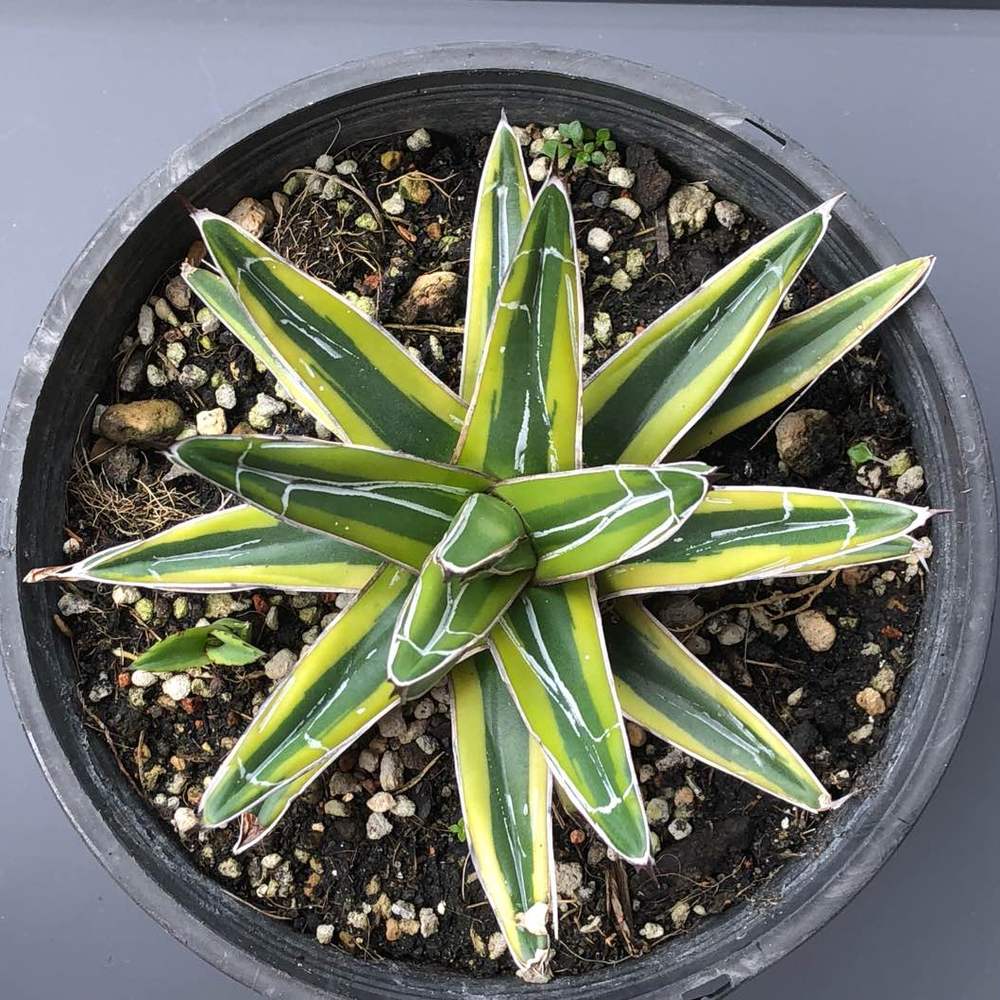植物经验
详细说明
Agave victoriae-reginae ‘Golden Princess’ is a beautiful form of the Queen Victoria Agave (Agave victoriae-reginae). As with the species this succulent plant is a very slow-growing small clump forming plant that can get up to 1 foot (30 cm) tall and up to 1.5 feet (45 cm) wide with tight-fitting, tapered leaves that end in a small terminal spine with the leaf margins smooth and spineless. This cultivar has broad yellow margins which, in addition to the already dramatic silver markings on the margins and center of the leaf, give this plant a tricolored look.
How to Grow and Care
Agave is not a difficult plant to grow. They’re slow-growing and dramatic and will even thrive on a bit of neglect. If you’re the type of person who likes to fuss with houseplants and water a lot, Agave is probably not the plant for you. If, however, you’re the type of person who likes to set it and forget it, and you have a sunny window, Agave might the way to go. Be aware that some of the large varieties will eventually outgrow your room (unless you have a large greenhouse), and Agave can be aggressive. They have irritating sap and sometimes very sharp thorns that can cause injuries to small children and even pets.
In general, Agave do not need to be repotted every year. Most of the species commonly found in cultivation grow very slowly and will take a long time to outgrow their pot. It’s also best to handle your Agave as little as possible, since they do not like to be disturbed. When you do repot, refresh the spent soil with new potting mix and make sure the plant is firmly anchored in its pot.
Growing Conditions
Light: Bright sunlight year-round. Consider moving your plants outside during the summer, where they can luxuriate in full sunlight, and make sure they get plenty of winter light.
Water: In spring, water with warm water just as the soil begins to dry out. Don’t let the soil become completely dry. In the winter and fall, when growth is suspended, water very lightly.
Temperature: They prefer warm spring and summer temperatures (70ºF/21ºC – 90ºF/32ºC) and cooler fall and winter temps (50ºF/10ºC – 60ºF/15ºC).
Soil: Use standard succulent or cacti potting mix.
Fertilizer: Feed in spring and summer; do not feed during fall and winter.
Propagation
Agave are difficult to grow from seed, and indoor plants will rarely flower anyway. Instead, use off-sets as the plant ages. In general, however, propagation of Agave grown as houseplants can be difficult, since plants may not produce off-sets at all, and once potted up, off-sets frequently take a long time to begin growing.
In most cases, it’s better to simply buy a new plant or take your propagation efforts to the greenhouse or glasshouse. If you are potting up off-sets, use a cactus soil and keep them in a place with strong light. Lightly water and give them plenty of time to form strong roots before repotting.
Repotting
In general, Agave do not need to be repotted every year. Most of the species commonly found in cultivation grow very slowly and will take a long time to outgrow their pot. It’s also best to handle your Agave as little as possible, since they do not like to be disturbed. When you do repot, refresh the spent soil with new potting mix and make sure the plant is firmly anchored in its pot. However, be careful not to pot the Agave too deep as that will encourage stem rot during the growing season. When repotting, use a fast-draining cacti or succulent mix. Do not use a mix that will become soggy or hold water.
How to Grow and Care
Agave is not a difficult plant to grow. They’re slow-growing and dramatic and will even thrive on a bit of neglect. If you’re the type of person who likes to fuss with houseplants and water a lot, Agave is probably not the plant for you. If, however, you’re the type of person who likes to set it and forget it, and you have a sunny window, Agave might the way to go. Be aware that some of the large varieties will eventually outgrow your room (unless you have a large greenhouse), and Agave can be aggressive. They have irritating sap and sometimes very sharp thorns that can cause injuries to small children and even pets.
In general, Agave do not need to be repotted every year. Most of the species commonly found in cultivation grow very slowly and will take a long time to outgrow their pot. It’s also best to handle your Agave as little as possible, since they do not like to be disturbed. When you do repot, refresh the spent soil with new potting mix and make sure the plant is firmly anchored in its pot.
Growing Conditions
Light: Bright sunlight year-round. Consider moving your plants outside during the summer, where they can luxuriate in full sunlight, and make sure they get plenty of winter light.
Water: In spring, water with warm water just as the soil begins to dry out. Don’t let the soil become completely dry. In the winter and fall, when growth is suspended, water very lightly.
Temperature: They prefer warm spring and summer temperatures (70ºF/21ºC – 90ºF/32ºC) and cooler fall and winter temps (50ºF/10ºC – 60ºF/15ºC).
Soil: Use standard succulent or cacti potting mix.
Fertilizer: Feed in spring and summer; do not feed during fall and winter.
Propagation
Agave are difficult to grow from seed, and indoor plants will rarely flower anyway. Instead, use off-sets as the plant ages. In general, however, propagation of Agave grown as houseplants can be difficult, since plants may not produce off-sets at all, and once potted up, off-sets frequently take a long time to begin growing.
In most cases, it’s better to simply buy a new plant or take your propagation efforts to the greenhouse or glasshouse. If you are potting up off-sets, use a cactus soil and keep them in a place with strong light. Lightly water and give them plenty of time to form strong roots before repotting.
Repotting
In general, Agave do not need to be repotted every year. Most of the species commonly found in cultivation grow very slowly and will take a long time to outgrow their pot. It’s also best to handle your Agave as little as possible, since they do not like to be disturbed. When you do repot, refresh the spent soil with new potting mix and make sure the plant is firmly anchored in its pot. However, be careful not to pot the Agave too deep as that will encourage stem rot during the growing season. When repotting, use a fast-draining cacti or succulent mix. Do not use a mix that will become soggy or hold water.
花相册 (7)
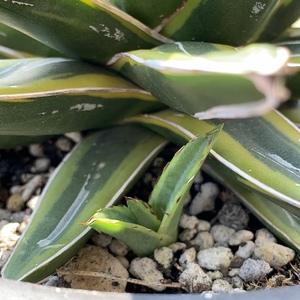

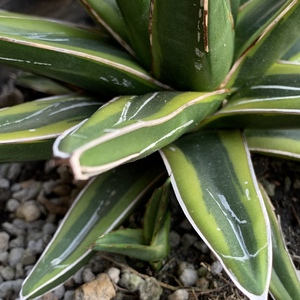
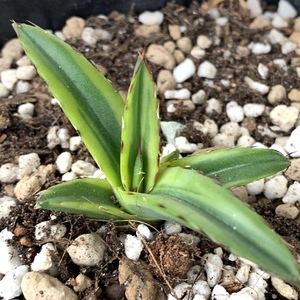
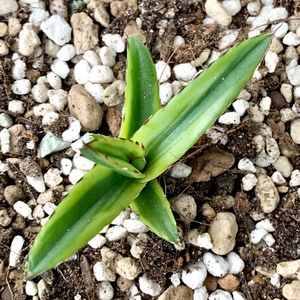
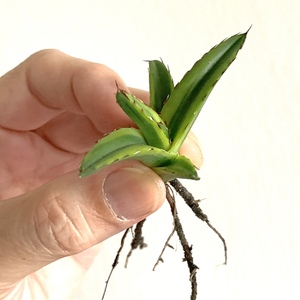
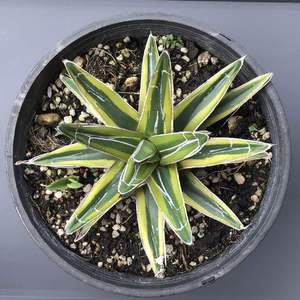
kensong
2019年02月09日

Pup growing well. Will wait another month before removing.


kensong
2019年01月06日

Harvested one pup and another has appeared.


kensong
2018年11月06日

Finally removed its pup and potted it. Healthy roots.






kensong
2018年07月02日

This is my first growing diary.




